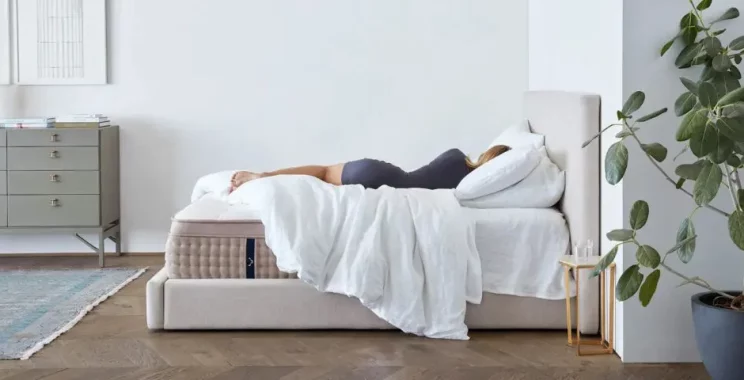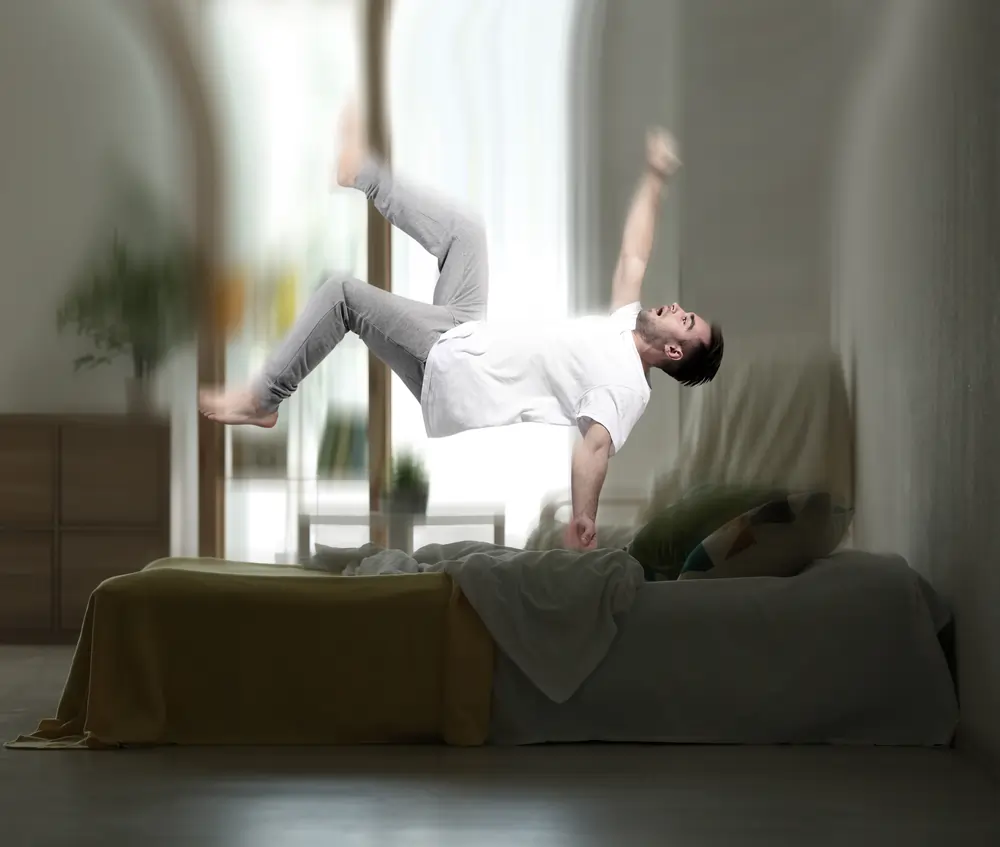REM Sleep Behavior Disorder: A Comprehensive Guide
Share
Fact checked
Reviewed by experts
Updated
December 22, 2022
Quick read
5 mins to read
List of Content
For many, dreaming can be a pure “mental” activity where dreams occur when the body is resting. However, the scenario is a little different for individuals who have REM Sleep Behavior Disorder (RBD).
Before we dive into the REM Sleep Behavior Disorder, let us understand what is REM sleep in the first place. REM- also known as Rapid Eye Movement is a brain state in which the body enters the relaxed state, accompanied by rapid fluttering movement of the eyelids and creation of dreams.
However, when our minds and body take a negative route during this REM sleep, it leads to REM Sleep Behavior Disorder.
By definition, the REM (Rapid Eye Movement) Sleep Behavior Disorder is a parasomniac condition where an individual acts out physically due to the unpleasant dreams he or she gets. This could be anywhere from movement of legs or hands to sudden vocal sounds during sleep. This is often termed as the dream-enacting behavior. In short, these are dreams that are accompanied with physical actions.

Interestingly, these dreams can even turn violent and the episodes can tend to worsen over time. While early episodes might involve a little activity, the later ones can be extremely violent.
Often, RBD is ignored and surprisingly, for years. In fact, there have been also cases when the dreams can turn out so violent that at some point, they are more likely to end one up in injuries—which could be either to the individual dreaming or the partner sleeping beside. On that note, let’s understand in-depth about REM Sleep Behavior Disorder and its symptoms.
Overview of REM Sleep Behavior Disorder
Sleep can be classified into 2 different states:
- NREM (Non-Rapid Eye Movement )
- REM (Rapid Eye Movement)
NREM sleep can again be classified into 3 stages. In REM sleep, occurrences of rapid eye movements are common followed by irregularity in breathing, elevated blood pressure, and paralysis. Speaking of paralysis in specific, it usually allows the individual to “act out” the dream he or she is imagining.
But, the brain remains highly active. In fact, the brain’s electrical activity during REM sleep is quite similar to when one is awake.

During the REM sleep, one doesn’t normally move. It is the normal sleep stage, which occurs multiple times at night. About 20% of the sleep one spends is REM sleep, which is the typical time of dreaming and primarily occurs in the second half of the sleep time.
Though the onset of the REM sleep behavior disorder is gradual, it can worsen with time. It might be linked with neurological conditions like Lewy body dementia, Parkinson’s disease, and multiple system atrophy.
Symptoms of REM Sleep Behavior Disorder
When it comes to REM sleep behavior disorder, rather than the normal temporary paralysis of your arms & legs (atonia), one physically acts out his or her dreams.
The onset might be sudden or gradual, and episodes can either occur multiple times or occasionally at nights. However, the disorder worsens with time.

Symptoms associated with REM sleep behavior disorder:
Dream-enacting behaviors usually include yelling, talking, kicking, grabbing, sitting, punching, jumping off from bed, and arm flailing. However, an acute form might occur during alcohol withdrawal or some sedative-hypnotic drugs.
- Movements like sleepwalking, grabbing, punching, kicking, jumping off from bed and arm flailing
- Noises like cursing, laughing, talking, emotional outcries, and shouting
- Recalling the dream even after being awake at the time of episode
A person with this disorder physically moves his or her limbs and may even walk. While some sleep talk, shout, scream, there have also been cases of punching or hitting. RBD becomes dangerous to the person who is sleeping beside the one who is affected by it. Fortunately, RBD can be treated.
Causes of REM Sleep Behavior Disorder
Though the actual cause of REM sleep behavior disorder is unknown, it might occur in connection with different degenerative neurological problems.
In about 55% of the individuals, the exact cause is not known whereas in 45%, it is said to be linked with a few factors like:
- Alcohol
- Tricyclic antidepressant
- Sedative-hypnotic withdrawal
- Use of serotonin re-uptake inhibitors
- Intake of antidepressants
Often, RBD precedes the progress of neurodegenerative diseases for years. In fact, 38% of the people suffering from RBD subsequently develop Parkinson’s disease in 12 to 13 years time on average.

The link between Parkinson disease and RBD is complex but not all individuals with RBD can develop Parkinson’s disease.
Often, RBD precedes the progress of neurodegenerative diseases for years. In fact, 38% of the people suffering from RBD subsequently develop Parkinson’s disease in 12 to 13 years time on average.
The link between Parkinson disease and RBD is complex but not all individuals with RBD can develop Parkinson’s disease.
Who is at the Risk?
There are multiple factors linked with the progress of REM sleep behavior disorder, which include:
- Men who are 50+ years old: Though this is true, in recent times, things have changed. Now, even women are being diagnosed with this disorder, especially young adults, children, and the ones below the age 50. This is also closely related to antidepressant use, narcolepsy, and brain tumours.
- People with certain neurodegenerative disorders: This usually includes Parkinson’s disease, stroke, dementia, Lewy bodies, and multiple system atrophy.
- People suffering from narcolepsy: This is a chronic sleep disease that’s characterised by excess daytime drowsiness.
- Certain medications: This is particularly true and increases the chances of this disorder while under any newer antidepressants. On the other hand, it can also be due to use of alcohol or drugs.
Recent evidence says that there might also be various personal or environmental risk factors involved, including farming, past head injuries, smoking, and exposure to occupational pesticides.
Diagnosis of REM Sleep Behavior Disorder
For the diagnosis to be accurate, a doctor dealing with parasomniac patients must examine the RBD symptoms thoroughly. The doctor might order to test the sleep study, where the individual stays in a special facility all night.
A team of medical experts will monitor:
- The breathing and sleep activity
- Brain’s activity or action
- Muscle movements
- Psychological well-being
- Shifts in behavior
The assessment also rules out the other probable causes or maybe, parasomnia.
Treatment of REM Sleep Behavior Disorder
The RBD treatment is basically successful. This means that the condition can be easily managed with two things:
- Prescribed medications
- Adapting proper sleep habits
As far as the medication is concerned, lots of drugs have been proven effective. The one that’s often recommended is clonazepam (in low doses), which can help about 90% of the individuals suffering from RBD.
Conclusion
This drug suppresses the muscle activity, relaxing the body in sleep. However, if clonazepam isn’t effective, a few antidepressants can help calm the violent behavior while sleeping.
This website does not offer medical advice nor professional medical services; rather, it is provided solely for educational, informational, and/or entertainment purposes. Individuals seeking medical advice should consult a licensed physician. The information provided should not be used for diagnosis or treatment of any condition, disease, or injury. When you have a medical condition, you should always talk to licensed doctor or other certified medical professional. You should never delay seeking professional medical advice or treatment based on the contents of this website. Call 911 or immediately go to the nearest emergency room if you think you may have a medical emergency. The contents of this website are provided “as-is”, Sleep Authority and its parent, subsidiaries, affiliates, employees, contributors disclaim any warranty of the information contained herein. Please contact using contact form to report any errors, omissions, misinformation, or abuse.
Sleep Authority is brought to you by Resident, the company that brings you Nectar, DreamCloud, Awara, Wovenly, Bundle, Home Well Designed and Level Sleep.









